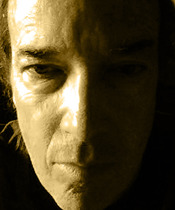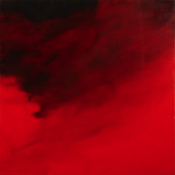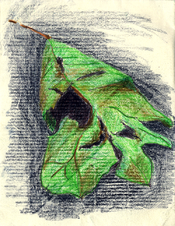 William Theodore Van Doren. Sunset from Stony Point, Albemarle County, Va. Oil on watercolor block, 16 x 20.
William Theodore Van Doren. Sunset from Stony Point, Albemarle County, Va. Oil on watercolor block, 16 x 20.
A cold rain at sunset.
The so-called Alley Field is a sloping area of some four or five acres of grass with a narrow lane at its entrance; the alley runs from a broken metal gate next to a small tangled dell of honey locust, blackberry and wild rose, then opens into the field.
Along one border, over the past couple of years, big oaks have been falling into the field – first one in a windstorm, then one after heavy rains, and another – and then yesterday I found a 60- to 70-foot red oak had simply heaved up out of its roots and crashed out onto the grass like a building in the street.
What’s funny – sort of – about these trees is that all of them have been very much alive. On yesterday’s oak I couldn’t even find the typical one big dead branch anywhere, and all the twigs were in bud and flexible. Yet a huge oak on the very same fenceline, a neighbor to all these collapsers, bleached dead for decades, which I’d cut 95% of the way through and then tried to help along to its fate by driving seven big iron wedges into the cut, refuses to fall, or budge, or even teeter just a little for me. No felling, no firewood. Kind of embarrassing.
Turns out the tree has a structure well known to timberers – and it’s the reason I originally didn’t just go ahead and cut through the remaining 5% of the trunk. It has two major upper portions of canopy, two massive uplifted limbs, almost perfectly balanced. So you can have no idea which way it’ll break – for example, on you.
Dangerous types of trees earn names from wood-cutters. A tree hung up on another is called a Widowmaker – a name that has effectively deterred me every time I’ve been tempted to mess with one. This other type of tree – the equally divided one – is called a Schoolmarm. Can’t make up its mind. Do you think these lumberjacks might have been just a little bit sexist?
 William Theodore Van Doren. Sunset from Stony Point, Albemarle County, Va. Oil on watercolor block, 16 x 20.
William Theodore Van Doren. Sunset from Stony Point, Albemarle County, Va. Oil on watercolor block, 16 x 20. Friday, February 5, 2010 at 07:47PM | by
Friday, February 5, 2010 at 07:47PM | by  BVD | in
BVD | in  Sunset Paintings | tagged
Sunset Paintings | tagged  Ethel Cole,
Ethel Cole,  Flint the foxhound,
Flint the foxhound,  Laura Owen Sutherland,
Laura Owen Sutherland,  Twitter,
Twitter,  Washington Post,
Washington Post,  photography,
photography,  snow,
snow,  snowmageddon,
snowmageddon,  snowpocalypse,
snowpocalypse,  trees | | Comments Off
trees | | Comments Off 

















